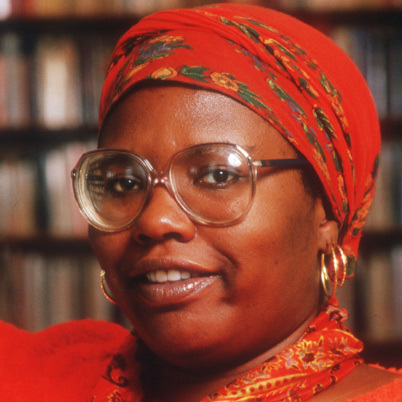The following is from the latest issue of the Full Stop Quarterly. You can purchase the issue here or subscribe at our Patreon page.

Late in Gloria Naylor’s 1996, a partially-fictionalized account of a year she spent under government surveillance, the omniscient narrator takes the perspective of NSA Deputy Director Dick Simon. Simon imagines the effect his machinations will have on Naylor, observing that although she will try to “write a book about her experiences this past year,” the story will be so outrageous no one will believe her. Publishers across the country will reject the book: “They’ll all shake their heads sadly over the fact that a writer of her caliber has gone bonkers” (124).
Simon’s prediction more or less came true. At the time of her death on September 28, 2016, Naylor’s literary reputation had diminished. She did find a publisher for 1996, but it was Third World Press, a much smaller venue than Penguin Books, who published her first four novels. That quartet included her National Book Award-winning debut The Women of Brewster Place (1982), Linden Hills (1985), Mama Day (1988), and Bailey’s Café (1992). Her 1998 sequel The Men of Brewster Place received less attention but was still well-reviewed, but 1996, her sixth and final novel, has been all but ignored.
Part of the problem may stem from Naylor’s lack of output in the last half of her career. After her initial creative explosion, the author spent much of her time working on a Mama Day sequel that never materialized. But the problem may also stem from the fact that readers in 2005 found it hard to accept the claims made in 1996. The novel eschews the shared universe of her other works for explicit autobiography. Furthermore, it presents Naylor as the target of a massive government campaign, culminating with the use of mind-control devices. The novel’s story gives way to addenda filled with secondary sources that prove such machinery exists.
Despite the stylistic and thematic breaks from her best-known works, 1996 upholds Naylor’s conviction that community overcomes oppression. In the fifteen years since the novel’s publication, Americans have experienced perpetual warfare, Fox News misinformation, foreign interference in our elections, and all manner of “fake news.” We’ve all become more paranoid, making Naylor’s message even more relevant.
Gloria Naylor’s Paranoid Style
As the NSA begins its operations against Naylor, she steadies herself against the fear taking hold of her.
Paranoia is a slow poison, and a lethal one. It usually starts with small things and then grows to color almost everything in your life. A harmless incident takes on gigantic proportions until “they” are everywhere and “it” is waiting to get you around every corner. As a native New Yorker, I had my healthy share of paranoia, and I like to think it kept me out of dangerous situations. [. . .] But was there someone—or something—waiting on that subway that you avoided? A true paranoid is convinced that there was. A healthy person forgets the whole thing as he settles down to his cab ride.
(23-24)
The story’s tension comes from the fear of such paranoia, as her character, who considers herself “someone who has asked for less than nothing” finds more and indicators of larger attention (84). What began as a spat between Naylor and her neighbor Eunice Simon on the South Carolina island St. Helene exploded into an operation involving multiple government agencies. Even as she experiences it, Naylor recognizes that most will find her story unbelievable.
As much as Naylor tries to fight against her fear, paranoia has long been part of American culture. In his foundational 1964 treatise “The Paranoid Style in American Politics,” historian Richard Hofstadter traces the feeling from the Puritan fear of witches to the rhetoric of Barry Goldwater’s campaign. According to Hofstadter, paranoia is the fear of outsiders that had pervaded the political climate of the time because “no other word adequately evokes the qualities of heated exaggeration, suspiciousness, and conspiratorial fantasy that I have in mind” (56). In the paranoid style, Hofstadter explains, “the feeling of persecution is central, and it is indeed systematized in grandiose theories of conspiracy” (57).
Paranoia has long been a key theme in American literature, particularly in the work of high postmodernists such as Don DeLillo and Thomas Pynchon. The Crying of Lot 49, Cosmopolis, and other novels portray late-capitalism as the period in which the Enlightenment finally collapsed on itself, forcing all of us little individualists to create our own reality. These authors approached their crises of identity with a humorous reserve, making a joke out of constant dread.
Take Jack Gladney, the protagonist of DeLillo’s White Noise. Fear of death seems to cripple Gladney, exacerbated by an “airborne toxic event” that engulfs his neighborhood. But despite these anxieties, Gladney seems unable to recognize the cost of real death. As the chair of the “Hitler Studies” department at his university, he reduces the horrors of the Jewish Holocaust to academic trivia. When Gladney takes action in the book’s final third to kill the man who has been manipulating and drugging his wife Babette, DeLillo buries the scene in allusions to Nabokov’s Lolita. The paranoia of the high postmodernists never feels real, remaining too reserved to reflect our lived experience.
But even in their absurd excesses, these writers never imagined anything to match our current situation. Fake news, mass surveillance, and global pandemic aren’t mere tropes to explore the life of the mind. They are our everyday lives.
Naylor’s 1996 abandons irony with its autobiographical approach. The main character is Gloria Naylor. Unlike Percival Everett, Paul Auster, or other authors who insert themselves into their work, Naylor isn’t playing a wry version of herself. In first-person present tense, she begins the novel by acknowledging that hers is “a good story” and she should “start at the beginning,” including details that one would expect only from an interview or a magazine profile (3). She talks about how her mother introduced her to the magic of books and writing, her experience as a Jehovah’s Witness, and the literary success that allowed her to buy a dream home on St. Helena. There’s no distance in her confession that she allowed an exterminator to place poison in her basement, knowing that her neighbor’s cats frequent her property. That’s an act of naked confession.
When the narrative shifts to third-person present tense to describe the phone call Dick Simon at the NSA gets from his sister Eunice, complaining that her neighbor Gloria Naylor poisoned her cat, 1996 shifts from a confessional to a work of paranoid fiction. We see inside the head of Simon and St. Helena Deputy Sheriff Miller, who run background checks and involve DEA agents to appease her. As the situation balloons, the story becomes less about Naylor dealing with one irritating neighbor and more about the United States government going to war against a single Black woman.
She is, in Hofstadter’s definition, an outsider, sublimating her feelings of persecution in a conspiracy narrative. As the trouble metastasizes, connections form against Naylor to unite those who would rather be enemies. With a platoon of investigators and agents working to make Naylor’s life into, as she puts it, “an open book,” (33) they become a community of readers, co-interpreting that book. Against the onslaught of enemies come together against her, Naylor turns to another group of outsiders, a diverse community who can make sense of her story: the actual readers of her book.
Communities of Oddities
This community of enemies places 1996 comfortably within Naylor’s larger oeuvre. Beginning with her 1982 debut, The Women of Brewster Place, Naylor always wrote about outsiders building communities, most often consisting of African American women. Her work rejects the individualism of a single protagonist for groups of people. Both Brewster Place books are “novels in stories,” in which narrators talk about (and sometimes contradict) one another. In Mama Day, quarreling lovers George and Cocoa offer their version of the truth, interrupted at times by a plural first-person narrator. Moreover, Naylor constructed a complex shared world, in which characters and places pop up from novel to novel—Brewster Place resident Kiswana Browne grew up in the affluent neighborhood Linden Hills, the wife of Linden Hills founder Luther Nedeed is also the great-grandniece of Mama Day, one of the narrators of Mama Day is born at the end of Bailey’s Café, and so on.
Despite these connections, Naylor’s characters rarely want to be living with one another. That’s particularly clear in the Brewster Place novels and in Bailey’s Café, which all deal with oppressed people stuck together. The tenants of Brewster Place live against a wall, as a concrete boundary separates the apartment building from the other, more “respectable” parts of the city. A metaphysical space that exists outside of time, Bailey’s Café appears only for those who need it most, a place of safety for its wearied clientele.
Bound together by desperation and oppression, the members of this community make up a diverse lot. Within Brewster Place, we find the faithful steadiness of matriarch Mattie Mae next to the immature Cora Lee, the penitent alcoholic Ben alongside the rapist C. C. Baker. In “The Two,” the devastating penultimate story in The Women of Brewster Place, lesbian couple Theresa and Lorraine move into the tenement after being chased from every other home they’ve had. But instead of finding sanctuary, they find suspicion and rejection. The diners in Bailey’s Café range from the sex worker Sadie to the Ethiopian runaway Mary to the cross-dressing academic Miss Maple. Their shared desperation provides some commonality, but not enough to erase their differences.
The characters who choose to live in the gated community Linden Hills and on the island Willow Springs have more agency, but they have little in common with one another. Each resident must grapple with their respective gatekeepers: the demonic land developer Luther Nedeed in Linden Hills and the Prospero-like medicine woman Mama Day. Naylor highlights the differences that form even under such strong central figures. Although all affluent, the residents of Linden Hills are separated into rings of deviance, modeled after the rings of Dante’s Hell. A living mixture, Mama Day is the child of a Dutch slave owner and an enslaved woman who refuses to control the citizens of Willow Springs.
Like the community of enemies who gather together to torture Naylor in 1996, none of these characters cohere into a single entity. They remain different, unique, and often antagonistic, even when they live together.
Loving the Enemies
Because of her devotion to difference within community, Naylor never aligns her characters along a simple good/bad axis. Nedeed of Linden Hills may be evil, but Naylor takes pains to show that he too is the victim of generational violence. C. C. Baker might be a violent rapist, but Naylor shows us how systemic racism and misogyny have twisted his mind.
Even though he attacks Naylor herself, Dick Simon receives the same complex portrayal. As the text makes clear, Simon himself bears no ill will toward Naylor. She is, in his opinion “one lousy woman, living alone,” who only comes to his attention because of his sister’s constant griping (37). This concern for his sister, and for the repercussions of ignoring her, drives his actions.
In the operation’s earliest stages, Eunice convinces Simon to act against his wishes by appealing to his familial guilt and by leveling charges of anti-Semitism against Naylor. The book tells us that Simon places no value on his Jewish heritage and that he has little affection for his family, but he cannot ignore Eunice’s charges. When he agrees to do the minimum for her, his familial and ethnic identities bleed into work identities. Because his work is his life, Simon has to keep up the investigation, because doing a half-job would violate the identity he constructed for himself in the workplace.
Naylor portrays every one of her government tormentors in a similar manner. None of them actually care about Naylor, but they have to attack her to keep up appearances. Sheriff Miller calls the DEA out of due diligence. When Naylor identifies the DEA agents following her, they need to save face by instituting other, more evasive procedures. A psychological ops team called “The Boys” conduct mentally torturous games against Naylor to impress Simon and secure better jobs in the future. Simon authorizes the use of government mind control devices because he needs to prove that he can’t be beaten by that “one lousy woman.”
No matter how cruel the characters’ actions might be, Naylor refuses to paint them as anything other than victims of their own momentum. Despite their power, they are weak, pushed into a community that demands they adhere to a particular identity. They are paranoid that their community members will see through them, turn against them, and so they move against Naylor to shore up their defenses.
Paranoia as Resistance
In “The Paranoid Style,” Hofstadter declares that paranoia “has a greater affinity for bad causes than good” (57). Certainly, the paranoia driving the agents is one such bad cause. But Naylor also builds a community of good causes in 1996, enabled by her paranoia.
In the novel’s first chapter, Naylor calls books “passports to a world of endless possibilities” (4). More than a bromide, the statement captures the purpose behind the novella. In the closing chapters, the NSA deploys machines that allow them to read Naylor’s thoughts and place thoughts into her mind. As thoughts such as “Fuck you. And fuck the human spirit. Just kill yourself” pop into her head, she begins to fight back in two ways (115, italics original). First, she spends time in the library, researching the stories of other surveillance victims and even those of what Simon calls “synthetic telepathy.”
But just as importantly, she fights back by reaching out to us, the readers. “They want me to feel that I was alone and worthless,” she writes (127). But the fact of her writing the book and publishing the book demonstrates that she isn’t alone. The novel ends with the same lines with which it began: “I didn’t want to tell this story. It’s going to take courage. Perhaps, more courage than I possess, but they’ve left me no alternatives. I am in a battle for my mind . . .” (3, 129). The fact of the book proves that she’s not alone. The fact that I’m reading the book proves that she’s not alone. The fact that you’re reading about the book proves that she’s not alone. We hear her.
And now, in 2020, perhaps we believe her. Even more than the addenda she includes in 1996, reports and interviews from those who experienced sympathetic telepathy, our lived experience tells us that our epistemology is under attack. At this point, we’ve all gone bonkers. In the same way that we can imagine a vast network of people working against us, we can also imagine a vast network of people suffering and feeling alone. Our paranoia can push us together and begin to restore us from our bonkers state.
That realization is Gloria Naylor’s final gift to her readers, the same gift she’s always given us: the sense that no matter how messed up we are, no matter how rejected we may be, we’re never alone.
Joe George writes about pop culture and literature for Tor.com, Bloody Disgusting, and Think Christian. He collects his work at joewriteswords.com and tweets nonsense from @jageorgeii.
This post may contain affiliate links.








